An Overview to Virtual Academy - Methods and Techniques
by Henrik Haggrén and Esben Munk Sørensen
Key words: Virtual academy, distance learning.
Abstract
Virtual academy is an academy which works within an
information network. It consists of a common understanding among its
members to provide their knowledge, expertise and research products to
each other and for co-operative use. The modern information technology
is most suitable for this purpose as the academy may function
internationally and at any distance. A profound option of a network is
that the information only is transferred and not necessarily the
people.
The infrastructure of a virtual academy consists of
three essential elements of information technology, namely the
network, the content and the graphics. The network is the realization
of current telecommunication technology whereas the content will be
mainly the data produced by the academy. The graphics includes the
physical perception of the information to work with.
Referring to a commercial press release by the
company AT&T on October 16, 1998: "Virtual academy is an
online centralized resource that provides teachers and educators with
access to web based professional development opportunities and
courses. It underscores AT&T's commitment to support lifelong
learning for teachers into the next century by helping them meet their
expanding credential requirements – anytime, anywhere." The
virtual academy of AT&T's is a collaboration with Penn State
University and a publishing company called T.H.E. Journal.
This division of the information technology to its
three elements is rather ambiguous. However, it is vital for an
academic discipline to distinguish these and develop its own future
accordingly. Although the driven force in developing the
infrastructure is no doubt the telecommunication society the value of
the academy depends entirely on its capacity to accumulate the
information, i.e. to collect data, to derive new knowledge, and to use
it when educating new engineers or scientists.
As it regards our professional discipline within
geoinformation sciences, we primarily produce the information content
but we also provide parts of the graphics. Thus the combination of the
information technology, the geoinformation science and the education
of surveyors would provide a most prosperous basis for creating a
virtual academy.
2. Virtual university and distance learning
The virtual university is the concept which was
recently adopted by e.g. Aalborg University, Denmark. The word
"virtual" in combination with university might at first
glance mislead, but is in fact nothing else than effective use of
modern information and communication technology. In Aalborg this
covers not only education and research but also administration
activities. Sørensen describes the virtual university being an
"integration within the university as a whole of the
technological tools which can prepare, develop and make more efficient
the university's services, especially education and research,
including those services which support education and research".
The guiding principles in Aalborg have been
described as strict demands upon quality, competency and openness. The
information technology should not be used for the sake of technology
itself but whenever any qualitative boost is expected. The competency
of a graduate can be qualified by the level of education, by the level
of both professional expertise and cross disciplinary awareness, as
well as by individual skills for communication, for creative work, or
for socio-economic judgment. The openness is argumented in order to
promote both internal and external accessibility to education,
knowledge and information.
The strategy within Aalborg virtual university is
emphasizing not only the global aspects but also the local ones. The
global aspects are essential on the university level in order to
complement the local faculties and their expertise. The local aspects
are essential on the research level. The university will maintain and
enforce its leading role in research fields which are ranked
internationally high in the university's strategy plan. The continuity
is crucial in attracting capable researchers and in recruiting them to
the university in the future.
In Canada, the TeleCampus of New Brunswick is a
good example of organized distance learning. It provides to the
residents of New Brunswick and other regions cost-effective, equitable
access to a range of training, information and educational services.
Special priority is given to residents of the more geographically and
socially isolated communities of the province. The province not only
profits from the educational content accessed by residents, but also
by their exposure to and active use of modern media. Among the values
upon which the network is based we may find the cooperation and
resource sharing, the partnership approach to development and
educational innovation, and the openness, creativity and innovation.
Access to distance learning is made possible
locally via a network of Community Learning Centres and globally via
TeleCampus, which is an online teaching and learning environment. It
collects courses from various universities and the access to these
courses is managed by a search able database. TeleEducation New
Brunswick provides assistance in the development and delivery of
distance education programmes.
3. Plans for FIG
The FIG Working group 2.2 on "Virtual academy
- distance learning" is specifically projected for information
dissemination concerning the virtual academy issues relevant to FIG,
by collecting hyper links to web sites relevant for distance learning
in surveying education, and by creating an educational database on
Internet as it regards respective tools and experiences. We are also
establishing contacts with the Internet and multimedia experts outside
FIG. Results will be reported to the XXII FIG Congress in Washington
in 2002.
The WG aims to organize an FIG Workshop on
"Virtual academy - distance learning" where current
activities within the topic will be presented. The workshop will be
held in Finland, Espoo in June 2001. According to the main theme of
the workshop, we try to accomplish it by organizing at least one
special session for online "distance learning" together with
some remotely locating group. As it regards the content of this
special session and the selection of co-organizing counterparts we
will be happy to have any response.
In order to prepare the program for the workshop we
will meet during the FIG Working Week in Prague.
Prof. Dr. Henrik Haggrén
Helsinki University of Technology
Institute of Photogrammetry and Remote Sensing
Otakaari 1
FIN-02150 Espoo
Finland
Tel. + 358 9 451 3900
Fax + 358 9 465 077
E-mail: henrik.haggren@hut.fi
Prof. Ph.D. Esben Munk Sørensen
Aalborg University
Department of Development and Planning
Fibigerstræde 11
DK-9220 Aalborg
Denmark
Tel. + 45 45 76 32 00 or + 45 96 35 84 05
Fax: +45 98 15 65 41
E- mail: ems@i4.auc.dk
An Overview to Virtual Academy - Methods
and Techniques
1. Introduction
Virtual academy is an academy which works within an
information network. It consists of a common understanding among its
members to provide their knowledge, expertise and research products to
each other and for co-operative use. The modern information technology
is most suitable for this purpose as the academy may function
internationally and at any distance. A profound option of a network is
that the information only is transferred and not necessarily the
people.
The infrastructure of a virtual academy consists of
three essential elements of information technology, namely the
network, the content and the graphics. The network is the realization
of current telecommunication technology whereas the content will be
mainly the data produced by the academy. The graphics includes the
physical perception of the information to work with.
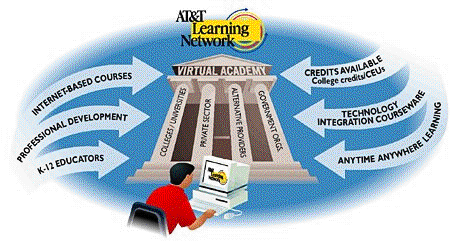
Referring to a commercial press release by the
company AT&T on October 16, 1998: "Virtual academy is an
online centralized resource that provides teachers and educators with
access to web based professional development opportunities and
courses. It underscores AT&T's commitment to support lifelong
learning for teachers into the next century by helping them meet their
expanding credential requirements – anytime, anywhere." The
virtual academy of AT&T's is a collaboration with Penn State
University and a publishing company called T.H.E. Journal.
This division of the information technology to its
three elements is rather ambiguous. However, it is vital for an
academic discipline to distinguish these and develop its own future
accordingly. Although the driven force in developing the
infrastructure is no doubt the telecommunication society the value of
the academy depends entirely on its capacity to accumulate the
information, i.e. to collect data, to derive new knowledge, and to use
it when educating new engineers or scientists.
As it regards our professional discipline within
geoinformation sciences, we primarily produce the information content
but we also provide parts of the graphics. Thus the combination of the
information technology, the geoinformation science and the education
of surveyors would provide a most prosperous basis for creating a
virtual academy.
2.
Virtual university and distance learning
The virtual university is the concept which was
recently adopted by e.g. Aalborg University, Denmark. The word
"virtual" in combination with university might at first
glance mislead, but is in fact nothing else than effective use of
modern information and communication technology. In Aalborg this
covers not only education and research but also administration
activities. Sørensen describes the virtual university being an
"integration within the university as a whole of the
technological tools which can prepare, develop and make more efficient
the university's services, especially education and research,
including those services which support education and research". (Munk
Sørensen, 1999).
The guiding principles in Aalborg have been
described as strict demands upon quality, competency and openness. The
information technology should not be used for the sake of technology
itself but whenever any qualitative boost is expected. The competency
of a graduate can be qualified by the level of education, by the level
of both professional expertise and cross disciplinary awareness, as
well as by individual skills for communication, for creative work, or
for socio-economic judgment. The openness is argumented in order to
promote both internal and external accessibility to education,
knowledge and information.
The strategy within Aalborg virtual university is
emphasizing not only the global aspects but also the local ones. The
global aspects are essential on the university level in order to
complement the local faculties and their expertise. The local aspects
are essential on the research level. The university will maintain and
enforce its leading role in research fields which are ranked
internationally high in the university's strategy plan. The continuity
is crucial in attracting capable researchers and in recruiting them to
the university in the future. (Munk
Sørensen, 1999).
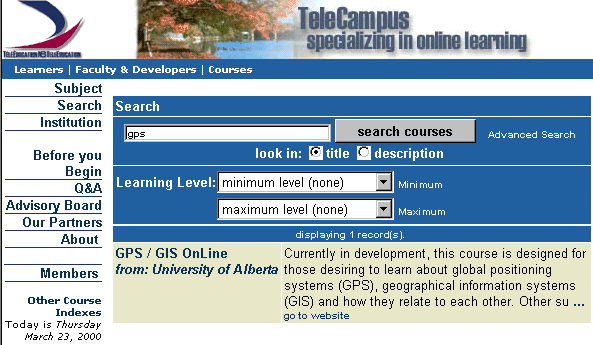
In Canada, the TeleCampus of New Brunswick is a
good example of organized distance learning. It provides to the
residents of New Brunswick and other regions cost-effective, equitable
access to a range of training, information and educational services.
Special priority is given to residents of the more geographically and
socially isolated communities of the province. The province not only
profits from the educational content accessed by residents, but also
by their exposure to and active use of modern media. Among the values
upon which the network is based we may find the cooperation and
resource sharing, the partnership approach to development and
educational innovation, and the openness, creativity and innovation.
Access to distance learning is made possible
locally via a network of Community Learning Centres and globally via
TeleCampus, which is an online teaching and learning environment. It
collects courses from various universities and the access to these
courses is managed by a search able database. TeleEducation New
Brunswick provides assistance in the development and delivery of
distance education programmes.
3.
Virtual academy
An academy is originally a suite for creative
thinking. In such a function the Greek academy lived for 900 years
before it was closed in 529. Thereafter it took more than five hundred
years before the European universities lived up again. Now they have
developed in 900 years to the modern academy of our time.
Meanwhile the academy has become more like an
educational institution serving the economy rather than a scientific
institution for its members. The current option for the virtual
academy is to let the academy and education functions join. In other
words, the academic research projects and the project based education
could face each other and interfere.
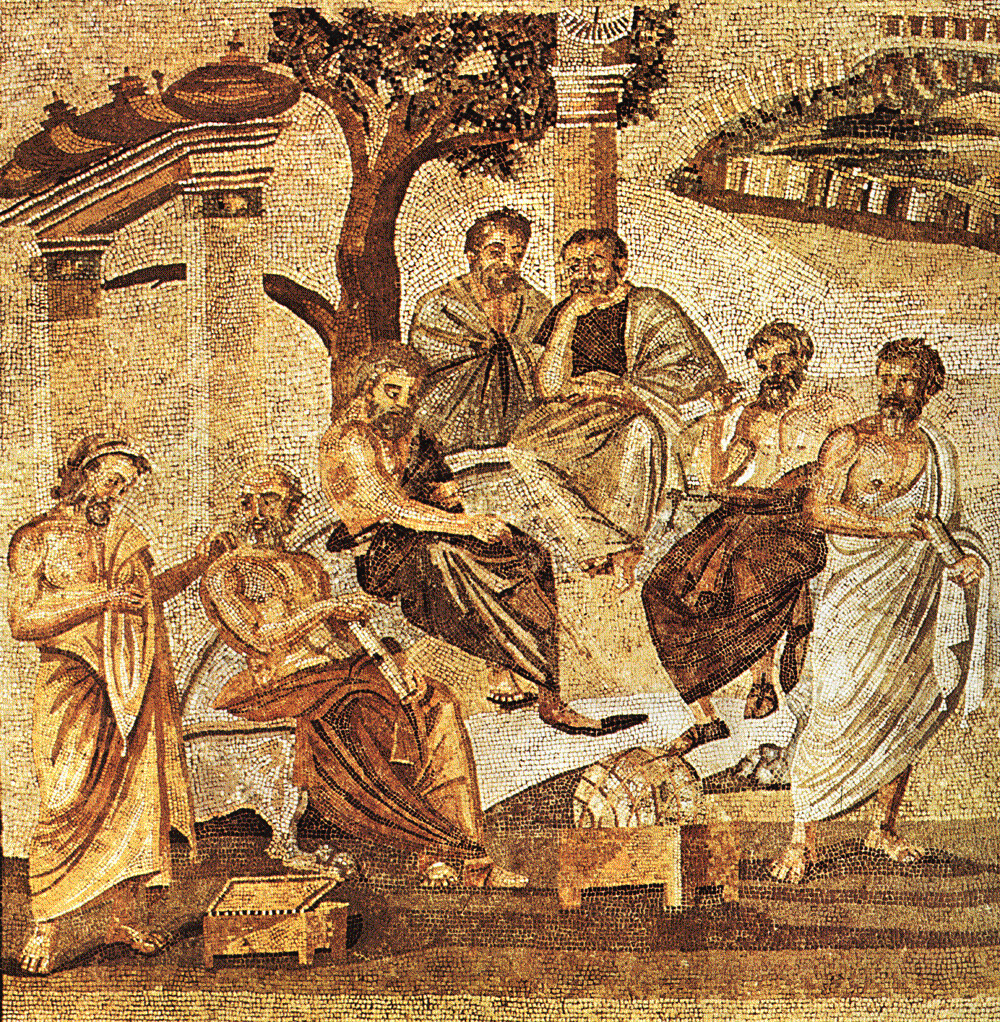 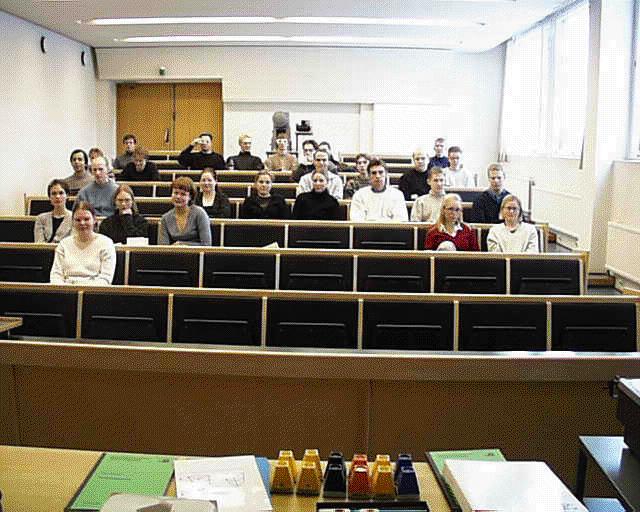
Plato and his students gathered in the garden of
the Greek hero Academos. At Helsinki University of Technology the
graduate students of geomatics still gather within the department
building. However, the department introduced in 1997 a virtual academy
called M-net which is now developing. The necessary infrastructure for
both internal and external telecommunication was based on Internet and
switched Fast Ethernet network.
The first phase in producing contents for the M-net
has consisted transformation of analog teaching material to digital
one and serving it both to the lecture rooms and for the students via
network. Although having nearly nothing to do with the information
accumulation this first contact within the M-net has shown to be vital
in experiencing the available technologies both in communication and
in producing the contents. The practical tools for producing and
serving the material have been the WWW and respective composers.
The second phase has been in activating students to
produce their own works within the network and to publish the material
for common use. Usually these have been seminar works and special
assignments which are published as hypertext documents. The third
phase will be the interactive one where the teachers and students
"solve" problems together.
Regarding the modules which will be necessary for
problem oriented education we may divide them according to pedagogic
levels. We call these levels "TEXTS", "TOOLS" and
"PROJECTS". The attached example is imaginary, but tends to
describe how a curriculum would be composed through the three.
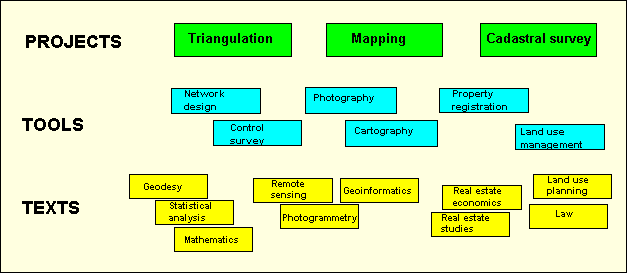
- The "TEXTS" level consists of individual courses and
contain the necessary lectures for detailed theory and links to
the references. The level also produces the necessary manuals
for later works.
- The "TOOLS" level contains software and all
technical support like instrumentation for students when
exercising the theory and parts of the technology. The tool
level is also for experimenting procedures by combining tools
and algorithms.
- The "PROJECTS" level is the one for solving
practical professional problems. This is performed according to
the project specifications and given data.
As a fourth level we add a level for
"RESEARCH".
4.
Information accumulation
|
Level |
Elements for information accumulation
-
Medium
-
Material
-
Competence
|
|
TEXTS |
theory, algorithms |
text books, manuals |
undergraduates |
|
TOOLS |
procedures |
software, hardware,
instrumentation |
bachelors |
|
PROJECTS |
data, specifications |
documentation |
masters |
|
RESEARCH |
knowledge, information |
theses, publications |
postgraduates
(incl. post doctorates) |
As it regards the virtual academy its prosperity
depends solely on its capacity of information accumulation. The four
levels of the academy can be characterized in the process of
information accumulation in following way:
-
On level of "TEXTS" the media for information
transformation is the theory and algorithms. These are published
in text books written primarily for pedagogic purposes or in
manuals written for professional purposes. The competence to
which this first level relates would be the one of
undergraduates.
-
The "TOOLS" level deals with procedures for building
functional modules based on theory and algorithms. These modules
consist of application software, necessary hardware and
instrumentation. The competence relates to the one of bachelors
and engineers.
-
The media for information transformation on the
"PROJECTS" level is any practical data necessary for
managing the project according to given specifications. The
documentation would contain case studies on previous works and
aspects of quality, legislation, standards, etc. The work is
based on combining previously learned procedures and the
information outcome would be the professional skill. The
competence relate to the one of masters or diploma engineers.
- The "RESEARCH" level deals with production of new
knowledge and information. The outcome consists of theses and
scientific publications. The competence is the one of
postgraduates and post doctorates.
The three first levels are the ones of the
educational domain. There the competence will be qualified by the
profession and controlled by respective market demand. The competence
of the "RESEARCH" level is qualified by the outcome of the
entire process of information accumulation and controlled by the
scientific community.
5. Networking
As it regards the virtual academy, it will be of
vital importance that the information accumulation becomes higher than
compared to the outcome of physical academy alone. Therefore the key
issue will be networking both internally and externally. As the
history of virtual academy is short, our experiences of active
networking are still minimal. However, it seems that the tokens of a
positive future are ever propagating.
Internally the accumulation function becomes
reactive. For example, the students are given parts of the research
projects where they may exercise the new procedures developed by the
researchers. Or, the researchers produce new parts of theory and
algorithms to text books and manuals and the students are provided
with this updated information.
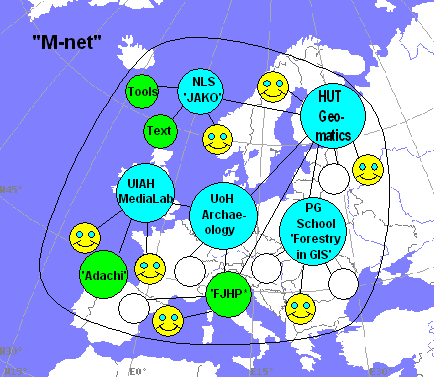
Externally the accumulation function becomes
supportive by outsourcing. The outsourcing is the way by which both
scientific and professional communities may cooperate in producing
common material for "TEXTS" and "TOOLS" levels, or
in organizing interdisciplinary campaigns on "PROJECT"
and "RESEARCH" levels. Within M-net we have currently
such actions with several institutions already. The abbreviations are:
HUT for Helsinki University of Technology, PG for post graduate, UoH
for University of Helsinki, UIAH for University of Art and Design
Helsinki, and NLS for National Land Survey of Finland. The 'JAKO',
'Adachi' and 'FJHP' are examples of project names.
6.
Examples in photogrammetry
Within HUT photogrammetry we started to develop our
own virtual academy in 1993 (Haggrén,
1996). At that time we built the necessary framework like the home
pages for all our courses. They consisted the necessary information on
the goal and contents of each course, the schedules for lectures and
exercises plus the reference information for the literature. The mode
was for all passive. Since then the courses have proceeded
individually. Most of the courses are now on the "TEXTS"
level. Some have reached already the "TOOLS" level and one
even "PROJECT" level.
The basic course in photogrammetry can be given as
an example of the "TEXTS" level. It consists of 13 chapters
corresponding to 13 lectures. The lecture material contains the
necessary theory parts and for some parts "TOOLS" for
demonstrations. The "TOOLS" can be activated within lectures
showing functional behavior of some photogrammetric principles or
procedures. The same "TOOLS" are available through network
and can be activated by students while learning the theory.
|
Categories |
Classes |
|
Object's action |
stable, moving, standby |
|
Measuring task |
orientation, geometry, motion, deformation |
|
Measuring dimensions |
partial (1D, 2D or 3D), total (2D or 3D),
volumetric (3D), photometry (2D or 3D) |
|
Object size |
very small, small, large, very large, extra
large |
|
Measuring accuracy |
moderate, good, high, very high, extreme high |
|
Measuring principle |
digital photogrammetry, analog photogrammetry,
range imaging, microscopic imaging, theodolites, CMM's,
mechanical or optical gauging, other optical techniques |
|
Number of measured points |
few points, tens of points, hundreds,
thousands, tens of thousands, hundreds of thousands (or
unlimited) |
|
Recording site |
on site, in laboratory, existing documents |
|
Processing site |
on line, off line |
The course of close range applications is an
example of the activity on the "PROJECTS" level. There we
have a data base consisting classified information of published
measurement cases and their procedures. For each case we have nine
categories according to which the case are to be classified. The
categories are object's action, measuring task, measuring
dimensions, object size, measuring accuracy, measuring principle,
number of measured points, recording site and processing time. Each
category is further divided to classes like "SMALL",
"LARGE", "VERY LARGE", and "EXTRA LARGE"
for the category of object's size, or "GEOMETRY",
"ORIENTATION", "MOTION", or
"DEFORMATION" for the category of measuring task. The
publications are reviewed and the cases classified by the students as
well. This data is then revised by the teacher together with the
students and added to the data base.
This production of data base functionally belongs
to literature research and represents thus the "PROJECTS"
level. While performing this kind of literature research the students
become to understand measuring problems, their solutions and selected
procedures.
7. Plans for FIG
The FIG Working group 2.2 on "Virtual academy
- distance learning" is specifically projected for information
dissemination concerning the virtual academy issues relevant to FIG,
by collecting hyper links to web sites relevant for distance learning
in surveying education, and by creating an educational database on
Internet as it regards respective tools and experiences (Artimo,
1999). We are also establishing contacts with the Internet and
multimedia experts outside FIG. Results will be reported to the XXII
FIG Congress in Washington in 2002.
The WG aims to organize an FIG Workshop on
"Virtual academy - distance learning" where current
activities within the topic will be presented. The workshop will be
held in Finland, Espoo in June 2001. According to the main theme of
the workshop, we try to accomplish it by organizing at least one
special session for online "distance learning" together with
some remotely locating group. As it regards the content of this
special session and the selection of co-organizing counterparts we
will be happy to have any response.
In order to prepare the program for the workshop we
will meet during the FIG Working Week in Prague.
References
Artimo, K., 1999, Different aspects to university
education of surveyors: Continuous development and management of
change, computer assistance, curricula contents and participation of
students. http://www.i4.auc.dk/fig2/aspects.htm
Haggrén, H. 1996, The use of WWW in teaching
photogrammetry and remote sensing at HUT.
http://ns.foto.hut.fi/publications/paperit/hhaggren/fig_1997.html
Munk Sørensen, E., 1999. On the roads to virtual
university -strategies and examples.
http://www.i4.auc.dk/ems/foredrag/99-06-03-suncity/index.htm
Munk Sørensen, E., 1999. Vision for Aalborg
Universitet - et 5-10 årigt perspektiv.
http://www.i4.auc.dk/ems/documents/vision-aau/default.htm
Prof. Dr. Henrik Haggrén
Helsinki University of Technology
Institute of Photogrammetry and Remote Sensing
E-mail: henrik.haggren@hut.fi
Prof. Ph.D. Esben Munk Sørensen
Aalborg University
Department of Development and Planning
E- mail: ems@i4.auc.dk
28 March 2000
|





